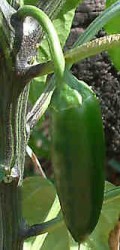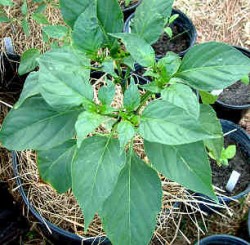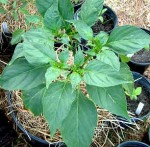Jalapenos in the Garden
Jalapenos have to be the most-recognized chile pepper around. You probably see them at the grocery store, and you’ve likely downed your share of them. But what about growing them in the garden?
The Humble Jalapeno
 You may not know this, but there are a multitude of jalapeno varieties. They all have the same basic pepper shape, but would you believe they come in different colors? Not to mention different sizes and Scoville units (“heat” to the uninitiated).
You may not know this, but there are a multitude of jalapeno varieties. They all have the same basic pepper shape, but would you believe they come in different colors? Not to mention different sizes and Scoville units (“heat” to the uninitiated).
Now most of the time the jalapenos you see and/or grow are the green peppers we all know and love. But they come in yellow and purple, too! And all varieties ripen to red (which can be fire-engine or quite deep burgundy).
How Hot — Or Not?
Yes it’s true, these versatile chile peppers come in several degrees of heat. There is the “regular” jalapeno, which is around 4,700 Scoville Units.
There’s also a “lite” variety called Tam Jalapeno that has less heat — somewhere in the vicinity of 2,000 SUs.
And for those who love these peppers but for whatever reason can’t take the heat — there is at least one variety that’s barely at 500 SUs.
To the best of my knowledge, there isn’t a super-hot jalapeno, but if you live in a warm climate, your peppers will get hotter as your weather warms up. In addition, if you let the peppers ripen to red, they are hotter yet!
Jalapenos — Does Size Matter?
You can look at this two ways — size of the pepper itself, or size of the plant.
There’s a variety called Mucho Nacho whose peppers are roughly twice the size of the standard jalapeno — great for anyone who can’t get enough of a good thing!
As far as the plants go — well, be prepared for the possibility of a large plant. Like 4 feet tall and just about as wide (yes, I’ve had them like that). That’s when they are planted in rich, well-drained soil and have plenty of warmth and at least 8 hours a day of direct sunlight.
If your soil, warmth or sunshine isn’t up to snuff, the plants will very likely be smaller; how much smaller depends on the conditions.  But 2 feet tall is a good guesstimate.
 You can also grow these chile peppers in containers (which is what I am personally doing now). A 5-gallon pot will give you plenty of peppers to pick.
You can also grow these chile peppers in containers (which is what I am personally doing now). A 5-gallon pot will give you plenty of peppers to pick.
Just make sure to keep it well-watered and fertilize it more often than you would if it were in the ground. (I like to fertilize weekly, with 1/3 to 1/2 strength liquid fertilizer — fish emulsion is my favorite.)
The plant in the picture is roughly 18 inches tall at the moment, and it’s come through some chilly weather the last month or so. But now that the weather is warming up, I expect it to grow at least another 12 inches by the time everything is said and done. For more information, check out my post on growing chile peppers in containers.
No peppers are ready for picking, but I’ve got plenty of blooms to tantalize me, knowing that most (if not all) will become a hot jalapeno.
While I don’t know for certain, I’m pretty sure this is the variety called Jalapeno M. It’s a nice open-pollinated variety that does well in most climates. If you need some tips, check out the growing chile peppers post.
Jalapeno peppers in the garden are easy to grow and quite forgiving. Give your plant(s) some care and you may end up with more peppers than you know what to do with!
About Chile Peppers
Chile, chili, hot — what’s the difference? None, really. These pungent peppers are often called by any of the above names.Â
Chile peppers are members of the genus Capsicum, and they are unrelated to black peppercorns (part of the Piper family). For convenience, however, we’ll only use the term “chile” when referring to these peppers. Please note, however, that there are several varieties that are actually have the word “chile” in their name.
Chile Pepper Facts
Where Did Peppers Come From? The hot chile pepper is a New World addition to the diet, discovered by none other than Christopher Columbus on his first voyage in 1492. Today, we know of more than 200 varieties, over 100 of which are indigenous to Mexico.
Are Peppers Good for You? Fresh chile peppers are loaded with Vitamin C — twice as much as citrus fruits! Fresh chiles also contain Vitamin A. What about dried? Well, drying chiles destroys most of the Vitamin C, but increases the Vitamin A content — up to 100 times! Some weight-loss programs advocate the use of spicy foods (chiles included), saying that the heat generated by the spice revs up the metabolism.
How Hot is “Hot”? Back in 1902, a scientist by the name of Wilbur Scoville devised a test to measure the relative heat of the chile peppers. This resulting scale is referred to as the “Scoville Scale”. For example, bell peppers register a “0-100” on the Scoville, while the mighty habanero registers a whopping “300,000+”. That’s hot!
Here’s a list of commonly eaten peppers, with their Scoville rating (from mildest to hottest):
- Bell peppers with a rating of 0-100
- Anahaeim peppers with a rating of 500-3,500
- Ancho/Poblano peppers with a rating of 500-1,000
- Pasilla peppers with a rating of 1,000-3,000
- Numex/New Mexico peppers with a rating of 3,000-4,000
- Hungarian peppers with a rating of 3,500-4,500
- Jalapeno peppers with a rating of 5,000-7,000
- Serrano peppers with a rating of 6,000-10,000
- De Arbol peppers with a rating of 15,000-30,000
- Cayenne peppers with a rating of 30,000-50,000
- Chipotle/Morita peppers with a rating of 75,000
- Chiltepin/Birdseye peppers with a rating of 50,000-100,000
- Scotch Bonnet peppers with a rating of 200,000
- Habanero peppers with a rating of 300,000+
- Habanero “Red Savina” with a rating of around 500,000
- Jolokia is now the official hottest, with a rating of over 1,000,000!
Now these numbers aren’t chisled in stone; for example, there are jalapenos that have practically no heat, as well as some that are extra hot. Different varieties of the same pepper can have different Scoville ratings. Add to that is this little fact; the hotter the climate where the pepper is grown, the higher the Scoville rating.
What Makes Chiles so Hot? A substance called capsaicin is what makes the chiles to hot! The more capsaicin, the hotter it is. Pure capsaicin tops out the Scoville scale with a rating of 16,000,000!
Too Hot! How Can I Cool my Mouth? First of all, do not drink beer, water or a carbonated beverage — it will just make things worse! Capsaicin is an oil, and these liquids just spread it around. Try drinking milk, or eating some sour cream (or ice cream). Dairy items neutralize the oil and cool the burn.
Can I Lower the Heat of a Pepper? Sure! If you want to reduce the flames (so to speak), you can “neuter” the pepper by paring away the interior ribs and removing the seeds. If the pepper is a really hot one, you might not notice a great difference, though.
How Can I Determine the Heat of an Unfamiliar Pepper? Assuming that you don’t want to taste-test the pepper, here’s a general rule-of-thumb — the bigger the pepper, the lower the heat. The reverse is generally true as well — the smaller the pepper, the hotter it is.
Where Can I Get Chiles? Chiles are increasingly available in grocery stores, but why not grow your own? They’re fun to grow, and you can be sure they’re fresh. Also, growing your own chile peppers allows you to grow the varieties that you like — not what the grocery store buyer thinks you should like.
How Long Will a Pepper Plant Live? This all depends on the species of pepper plant. There are three main cultivated species: Capsicum annuum, Capsicum frutescens, and Capsicum chinense. Most peppers grown are of the Capsicum annuum species, and so are annual plants (living only one year). The Tabasco pepper (Capsicum frutescens) also lives a similar time. On the other hand, Capsicum chinense, otherwise known as the Habanero or Scotch Bonnet, is a perennial in a semi-tropical or tropical environment. In addition, the Capsicum baccatum, of which Ajis are a member, can also occasionally live more than one season.
